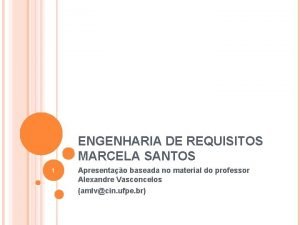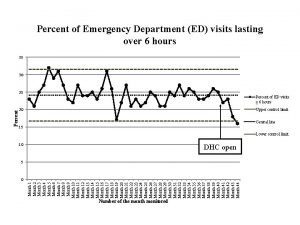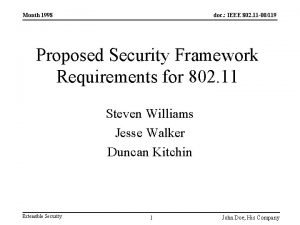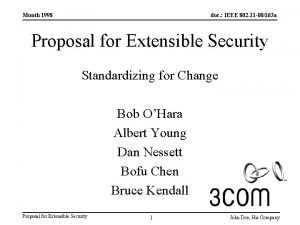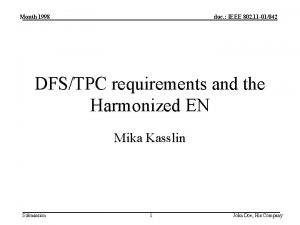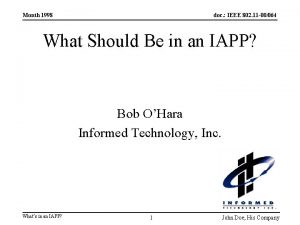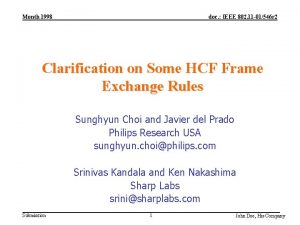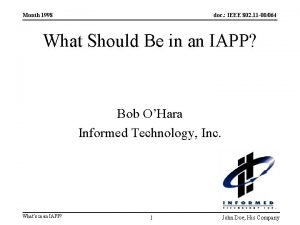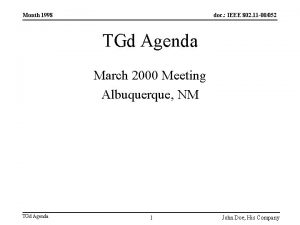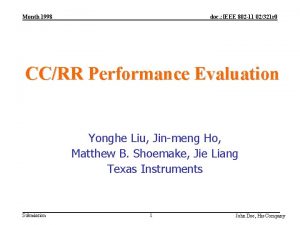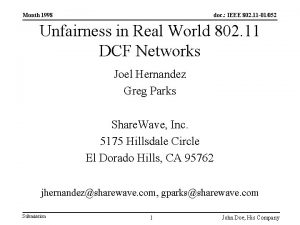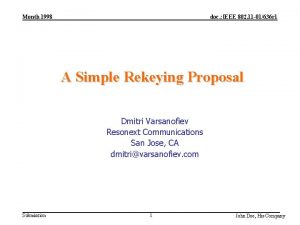Month 1998 doc IEEE 802 11 00065 a















- Slides: 15

Month 1998 doc. : IEEE 802. 11 -00/065 a Extensible Security Standardizing for Change Bob O’Hara Albert Young Dan Nessett Bofu Chen Bruce Kendall Extensible Security 1 John Doe, His Company

May 2000 doc. : IEEE 802. 11 -00/065 a Security Environment • The choice of “best” security algorithms for authentication and privacy are not static over time • Affected by – – – Government regulation Newly discovered attacks Advances in mathematics Advances in processing capabilities Newly discovered faults Uninformed opinions of users Extensible Security 2 Bob O’Hara, et al

May 2000 doc. : IEEE 802. 11 -00/065 a Standardization Environment • Define solution(s) based on current conditions and best estimates of future • Solution is fixed and generally inflexible • Difficult to change – Requires a group (like us) to meet and accomplish the task – Generally, will not take less than 18 -24 months to complete a change Extensible Security 3 Bob O’Hara, et al

May 2000 doc. : IEEE 802. 11 -00/065 a Standardize for Change • Standardize mechanism(s) that are not rigid – Based on negotiation, rather than fixed requirements in the standard • Allow for ongoing adaptability and innovation • Provide processes that encourage/enforce exchange of information • Provide one (or two) starting points using the new mechanism Extensible Security 4 Bob O’Hara, et al

May 2000 doc. : IEEE 802. 11 -00/065 a Three Alternatives • Use the existing authentication algorithm number field • Redefine the authentication algorithm number field • Extend the authentication frame format to add an information element Extensible Security 5 Bob O’Hara, et al

May 2000 doc. : IEEE 802. 11 -00/065 a Use the Authentication Algorithm Field • Define a registration process that allows anyone to petition the IEEE for a new value to be used in this field – Exactly the same as the process used for OUI and Ethertype registration • See http: //standards. ieee. org/regauth/oui/index. shtml and http: //standards. ieee. org/regauth/ethertype/index. html • Require full disclosure of information to enable multivendor interoperability Extensible Security 6 Bob O’Hara, et al

May 2000 doc. : IEEE 802. 11 -00/065 a Redefine the Authentication Algorithm Number Field Privacy Algorithm Authentication Algorithm • Change the field to be the Security Algorithms field • Define two new subfields – Privacy Algorithm Number, 8 bits – Authentication Algorithm Number, 8 bits • Define privacy algorithm to be 40 -bit WEP only when authentication is not open system Extensible Security 7 Bob O’Hara, et al

May 2000 doc. : IEEE 802. 11 -00/065 a Use New Information Element • Define a single new value for the Authentication Algorithm field (say 2) that indicates that the new element is present, following the challenge text – In the first Authentication frame – Or in every Authentication frame • The new Information Element several fields – Identify both the authentication algorithm and privacy algorithm, independently – Include key lengths for both privacy and authentication Extensible Security 8 Bob O’Hara, et al

May 2000 doc. : IEEE 802. 11 -00/065 a Authentication and Privacy Information Element Field Length (octets) Element ID 1 Length 1 Authentication Algorithm 2 Authentication Key Length 2 Registering OUI-A 3 Privacy Algorithm 2 Privacy Key Length 3 Registering OUI-P 2 Extensible Security 9 Bob O’Hara, et al

May 2000 doc. : IEEE 802. 11 -00/065 a Merits of Flexibility • Vendors can adapt quickly to changes in the security environment • The standard does not need to be changed for this reason in the future • The market can select the “correct” algorithms • Encourages both competition and interoperability within the scope of the standard Extensible Security 10 Bob O’Hara, et al

May 2000 doc. : IEEE 802. 11 -00/065 a Relative Merits of Alternatives • Using only the Authentication Algorithm field – No change is needed to the Authentication frame format – Minimizes likelihood of interoperability problems with existing APs • Unless AP performs only a single test to differentiate between the two current allowable values – Does not easily provide a mechanism for selecting privacy algorithm or key length, without overloading the definition of this field Extensible Security 11 Bob O’Hara, et al

May 2000 doc. : IEEE 802. 11 -00/065 a Relative Merits of Alternatives • Redefining the authentication algorithm number field – No change is needed to the Authentication frame format – Minimizes likelihood of interoperability problems with existing APs • Unless AP performs only a single test to differentiate between the two current allowable values – Adds capability to select both privacy and authentication algorithms in the authentication exchange Extensible Security 12 Bob O’Hara, et al

May 2000 doc. : IEEE 802. 11 -00/065 a Relative Merits of Alternatives • Using a new information element – Changes basic format of Authentication frame • Adds new information element to first (or each) Authentication frame – Likelihood of interoperability problem is slightly greater than with previous methods – Allows independence of choice for both authentication and privacy algorithms – Provides significantly greater identifier space • Algorithm values are assigned independently to each OUI • Provides for the possibility that half of each identifier space can be reserved for “experimental” values that need not be registered Extensible Security 13 Bob O’Hara, et al

May 2000 doc. : IEEE 802. 11 -00/065 a Recommendation • Define the Authentication and Privacy information element, its fields, and its usage • Define a registration procedure – Registrant must have an IEEE-assigned OUI – Complete algorithm and handshake protocol details must be provided, including external references (if any) – In exchange for providing registration services, IEEE gets right to publish details (preferably on web site) • Include a pointer to the registration web site in the standard Extensible Security 14 Bob O’Hara, et al

May 2000 doc. : IEEE 802. 11 -00/065 a Procedural Stuff • Write a proposal to IEEE Registration Authority Committee – What is to be registered? – Why should it be registered? – What special procedures are needed? • Next RAC meeting is at July 802 plenary • Work with IEEE to implement the procedures Extensible Security 15 Bob O’Hara, et al



